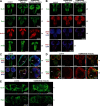Drosophila Tet Is Required for Maintaining Glial Homeostasis in Developing and Adult Fly Brains
- PMID: 35396259
- PMCID: PMC9045479
- DOI: 10.1523/ENEURO.0418-21.2022
Drosophila Tet Is Required for Maintaining Glial Homeostasis in Developing and Adult Fly Brains
Abstract
Ten-eleven translocation (TET) proteins are crucial epigenetic regulators highly conserved in multicellular organisms. TETs' enzymatic function in demethylating 5-methyl cytosine in DNA is required for proper development and TETs are frequently mutated in cancer. Recently, Drosophila melanogaster Tet (dTet) was shown to be highly expressed in developing fly brains and discovered to play an important role in brain and muscle development as well as fly behavior. Furthermore, dTet was shown to have different substrate specificity compared with mammals. However, the exact role dTet plays in glial cells and how ectopic TET expression in glial cells contributes to tumorigenesis and glioma is still not clear. Here, we report a novel role for dTet specifically in glial cell organization and number. We show that loss of dTet affects the organization of a specific glia population in the optic lobe, the "optic chiasm" glia. Additionally, we find irregularities in axon patterns in the ventral nerve cord (VNC) both, in the midline and longitudinal axons. These morphologic glia and axonal defects were accompanied by locomotor defects in developing larvae escalating to immobility in adult flies. Furthermore, glia homeostasis was disturbed in dTet-deficient brains manifesting in gain of glial cell numbers and increased proliferation. Finally, we establish a Drosophila model to understand the impact of human TET3 in glia and find that ectopic expression of hTET3 in dTet-expressing cells causes glia expansion in larval brains and affects sleep/rest behavior and the circadian clock in adult flies.
Keywords: 6mA DNA demethylation; Drosophila Ten-eleven translocation (Tet); Drosophila brain; brain tumor; human TET Drosophila model; optic chiasm glia.
Copyright © 2022 Frey et al.
Figures









References
-
- Battye R, Stevens A, Jacobs JR (1999) Axon repulsion from the midline of the Drosophila CNS requires slit function. Development 126:2475–2481. - PubMed
Publication types
MeSH terms
Substances
LinkOut - more resources
Full Text Sources
Molecular Biology Databases
